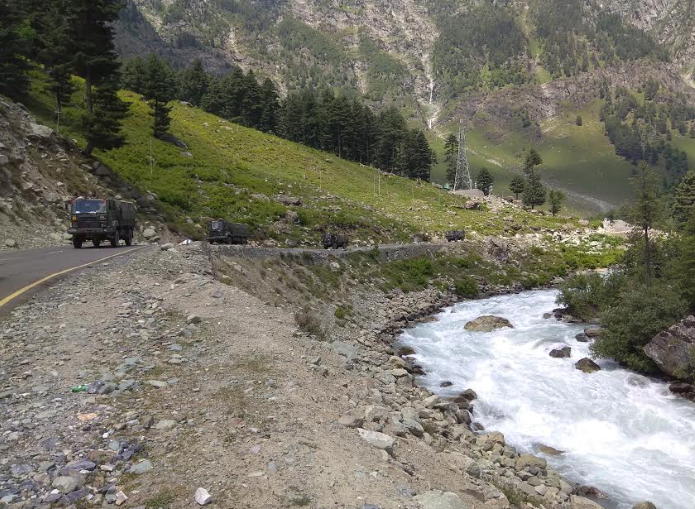Face-Off With China: Locals in Ladakh Decry Tardy Infra Works, Communication Blackout

Srinagar: Heightened tension along the Line of Actual Control (LaC) in Eastern Ladakh has scaled up apprehensions among local residents in the newly created Union territory, with many of them denouncing lack of proper infrastructure and communication access, especially after hostilities with China started building up since over a month now.
Border tension between India and China escalated in the strategic Galwan Valley following which 20 Indian soldiers were killed and scores of others were left injured in a "violent face-off" on Tuesday, the first such incident in four decades. The incident cost lives of soldiers on both sides, as per Army sources.
Meanwhile, inhabitants in the region continue to remain alarmed in the wake of Chinese aggression, their fears compounded by years of slow progress on key infrastructure projects, limited road connectivity and communication blackout.
The access to forward areas of Eastern Ladakh has been restricted with communication services, including mobile networks, snapped.
"We do not know anything about the current situation as all communication has been snapped in these border areas for almost 15 days now. We are planning to send a councillor there to get a first-hand account from these areas," Leh's Chief Executive Councilor of the Ladakh Autonomous Hill Development Council (LAHDC), Gyal P. Wangyal, told NewsClick.
Not just in the forward areas of Ladakh, where the situation remains tense in wake of the fresh conflict between Indian soldiers and personnel from the Chinese People's Liberation Army (PLA), but movement on the vital Srinagar-Leh highway has also been disrupted since then.
Traffic on this key highway, which passes through the treacherous Zojilla, Drass and Kargil terrain, is facing such obstructions for the first time since the Kargil war in 1999.
The 400-km-long National Highway 1D, which opened for public movement in 1974, is the only road between Srinagar and Leh, and one of the only two land routes that connects Ladakh with the outside world.
The route remains cut-off during winter season and is often temporarily closed due to inclement weather conditions. This time, however, traffic movement has been restricted, particularly after clashes at LaC.
The highway between Sonmarg and Leh witnessed increased troop movement and vehicles transporting heavy artillery, which further moved toward areas in Eastern Ladakh, including Galwan Valley. Civilian movement on this highway has been interrupted with many, including the media, not being allowed to visit the hostile region.
Abdul Aziz, a nomadic Bakerwal tribal, says he has been waiting for over a month to travel to the region but has not been able to do so due to the ongoing crisis. "I have already sent my livestock across Zojilla but, I am stuck here in Srinagar," Aziz said.
Hundreds of Bakerwals make the arduous journey to Ladakh during summer with their livestock. Aziz says, many of them are stuck at different places on the highway near Sonmarg, Drass and Minamarg and their travel to destinations like Minamarg has been stalled.
This, Aziz says, is reminiscent to what transpired during the Kargil War. "During that time, our annual migration was disrupted for years before it was resumed. We fear a similar situation again," he adds.
Social activist Sajjad Kargili, who independently fought the previous Lok Sabha elections, also says the fresh incident along the LaC has renewed fears among residents of Kargil, the epicentre of 1999 war between India and Pakistan.
"There is definitely a scare among locals here due to the current escalation," he says.
Sajjad says the Central government has not been able to build key infrastructure in the region and the lack of timely work on developmental projects makes them more "vulnerable."
"We live on the hostile borders and developmental work here is directly connected to national security. There are so many ongoing road construction projects in Leh, Kargil, Nubra and Zanskar areas, where work has not been completed," he says.
The fresh confrontation in Ladakh is being seen as a result of work on a key road near Pangong Tso lake and Darbuk-Shyok-Daulat Beg Oldie road in Galwan Valley by India which has been trying to improve infrastructure on their side as a part of military preparedness against Chinese domination along the LaC.
According to local administration officials in Ladakh, despite the hostility, developmental work on various infrastructure projects, including on key highways in Ladakh, has not stopped despite the fresh border skirmishes.
Earlier this week, as many as 1,600 non-local labourers were reportedly on their way to the forward areas of Ladakh region to continue work on infrastructure projects of the Border Roads Organisation. The workers, however, had to be quarantined, according to the official.
Get the latest reports & analysis with people's perspective on Protests, movements & deep analytical videos, discussions of the current affairs in your Telegram app. Subscribe to NewsClick's Telegram channel & get Real-Time updates on stories, as they get published on our website.

















